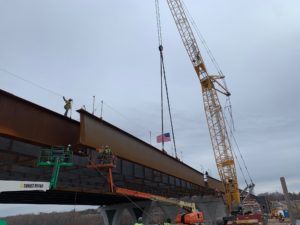
The Delaware River Joint Toll Bridge Commission has announced the Scudder Falls Bridge Replacement Project along I-295 Pennsylvania and New Jersey is on the cusp of reaching the 90-percent-completed mark by the end of March and achieving substantial completion in December.
A major construction milestone was reached on Tuesday, March 16, when the last of 98 steel support girders for the Scudder Falls (I-295) Toll Bridge’s second parallel span was lifted and bolted into place. The second span is immediately downstream of the first bridge span that opened to traffic in July 2019. When the fully completed, the upstream span will carry Pennsylvania-bound traffic and the downstream span will carry New Jersey-bound traffic.
The bridge project, which started construction in 2017, also includes highway widening on the Pennsylvania side, reconstructed or realigned interchanges near both ends of the bridge, and an array of other improvements across a 4.4-mile long project area along I-295 in Ewing, N.J. and Lower Makefield, PA. The project now has reached the point of being approximately 88 percent completed.
The completion of the girder installations on the new bridge’s second span is a pivotal milestone because it ends a complex logistical task of shipping girders to the construction site and then installing them into place.
Girder erection for the second bridge span started on New Jersey side, taking place from late May to late June 2020. With the completion of supporting substructures on the Pennsylvania side later in the year, girder erection resumed in early December and continued, with brief interruptions, until mid-March.
The girder sizes averaged 10-feet high and 135-feet long, and weighed approximately 60 tons. Like the already-operational upstream bridge, a total of 98 individual girders were used in the construction of the adjacent downstream span. The girders were fabricated in Williamsport, PA. and then trucked on pre-assigned routes to the respective work site on the New Jersey or Pennsylvania side.
Each of the dual bridges (they will not be identical twins) have seven continuous steel-beam lines made up of 14 individual girder sections that were lifted by crane and bolted together atop the supporting masonry substructures (piers or abutments). The utilization of multiple steel beam lines provide “redundancy,” a critical strength and structural safety feature missing in the former 59-year-old, functionally obsolete Scudder Falls Bridge – now completely dismantled down to the river bottom.
All totaled, 196 steel girders were used to construct the two dual spans – a total of approximately 11,760 tons of steel.
Now that the girder installations are completed on the second span’s superstructure, the project contractor can now focus on the next phases of bridge construction. The large crane used to lift the individual girders into place was removed from the project area on Wednesday. Work also has begun on converting a nearby staging area at the corner of Woodside and River roads into a Commission-owned wetlands buffer.
On the bridge itself, crews will complete bolting together the lines of installed girders. Workers will then install cross-bracing between the girders followed by galvanized-steel corrugated deck pans (form work), steel rebar, and deck joints through the spring. These preparations will allow for the pouring of the concrete deck slabs and a driving-surface layer of polyester-polymer concrete in the summer.
If the current schedule holds, the downstream span would be completed and opened only to New Jersey-bound traffic in late August. At that point, a widened and reconstructed I-295 EB approach roadway in Pennsylvania and a widened and reconstructed I-295 SB lanes off the bridge on the New Jersey side also would be opened to traffic.
The project would then enter Stage III with traffic moved to the outside lanes on the two side-by-side bridges. This will allow construction crews to make final transitional improvements on the approach roadways and the exit/entry ramps at both ends of the bridge. Work also will take place in completing the highway median on the New Jersey side.
Stage III work is expected to be completed in mid-December, at which point the two bridge spans will be able to carry their respective full capacities of traffic. The current upstream span would carry three through lanes of Pennsylvania-bound traffic along with an additional auxiliary lane between the on ramp from Route 29 in New Jersey and the off ramp to Taylorsville Road in Pennsylvania. The new downstream span would carry three through lanes of New Jersey-bound traffic along with two auxiliary lanes that would facilitate safe traffic merging from the I-295/Taylorsville Road interchange in Pennsylvania to the I-295/Route 29 and I-295/CR-579 interchanges in New Jersey.
The contractor is expected to then conduct punch-list work to fully complete the project in the spring of 2022.





